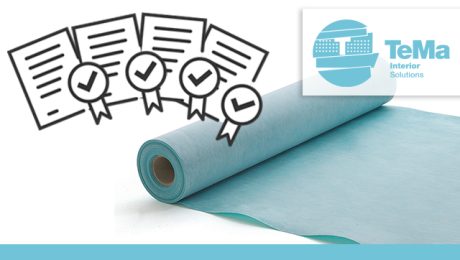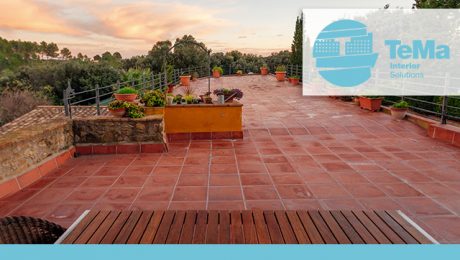TH2 Stop: certified waterproofing
As mentioned many times before, the problem of moisture and water vapour on walls and floors, both indoors and outdoors, is not to be underestimated. TH2 Stop from TeMa Interior Solutions, consisting of three layers, is the waterproofing membrane that fulfils its waterproofing function by blocking any damage caused by moisture before it forms.
Once the membrane has been applied, any surface can be laid over it: tiles, stone, cement resin, marble or plaster. It’s the ideal solution for insulating the bathroom from moisture and water vapour, keeping the surfaces healthy for a long time: as long as the life of the home. In renovations and in new buildings, installers prefer TH2 Stop for its safety and user-friendliness.
TH2 Stop is guaranteed to provide top performance and has been certified in Europe and beyond. US certification was obtained by passing the tests required by various standards:
- The ANSI A118.10 (American National Standard Specifications) regulation sets out the standard requirements for load-bearing, bonded, waterproof membranes for laying ceramic and natural stone tiles.
- The ASTM E96 standard for assessing membrane water vapour transmission, in accordance with the Annex.
- The ASTM C627 standard for passing the Robinson Wheel Test, with the highest Heavy Commercial rating.
At the European level, TH2 Stop has also obtained CE certification through ETA (European Technical Assessment) in compliance with ETAG 022 Class A and C (waterproofing bonded with ceramic tiles). The directive concerns watertight covering kits for floors and/or walls of indoor wet rooms.
TH2 Stop and its accessories can be used to seal joint areas between panels or adjacent sheets and all critical points, thereby creating a fully waterproof system.
For innovative products or products not yet covered by a standard, an alternative to harmonised EN standards is the issuing of a European Technical Assessment (ETA). This document consists of the approval of the suitability for use of a certain product, consistent with ETAG guidelines. ETAG guidelines are prepared under an EC mandate by a special European organisation EOTA (European Organisation for Technical Assessment) comprising national administrations and institutes responsible for assessing the technical suitability of innovative products.
TH2 Stop also passed the tests required by the European AbP (Allgemeines Bauaufsichtliches Prufzeugnis) standard, the most stringent in the industry. This building inspection certificate issued by accredited German building authorities in the sector allows the product to be distributed in the German market.
- Published in Baths and showers rooms, INTERIOR, Levelling, or structural, waterproofing panels, Waterproofing system with membranes
Protecting outdoor flooring with drainage geocomposites
Autumn precipitation, winter frosts and scorching summer heat may even be followed by a downpour lasting a few minutes. Terraces and balconies, or outdoor flooring in general, are affected by seasonal and sometimes daily weather events and temperature fluctuations that put the resistance of flooring at risk.
So how can we protect them?
Drainage geocomposites are the solution, but let’s take a closer look at them and their functions.
What are drainage geocomposites and when should they be used?
They are geosynthetic materials with a drainage core bonded to a non-woven filtering fabric. They can be used on walls, underground structures, flat roofs, trafficable roofs, flat green roofs, as well as terraces, balconies and outdoor flooring.
TeMa Interior Solutions suggestsT-K NW and T-K Net, polyethylene studded membranes bonded to a non-woven fabric that acts as a filtering layer for T-K NW or a HDPE mesh for T-K Net.
What are the functions?
The functions of geosynthetic products are set out in the UNI EN ISO 10318 standard.
![]()
Drainage
As the name implies, the main function of geosynthetic products is to drain any water that may seep into the screed. Passive capillary drainage eliminates the risk of stagnant water in the system and, if there are rooms below, prevents moisture from damaging the insulating layer.
![]()
Protecting the waterproofing layer
Damage to the waterproofing layer causes significant and immediately visible problems. Moisture and water penetrating into deeper layers, compromise the durability and strength of the structure, causing cracks in tiles. Protection is therefore necessary.
![]()
Distributing the load
Flooring often has to withstand heavy loads, such as outdoor tables, sunshades, large plant pots etc…. Using studded membranes, which are highly resistant to loads, allows the screed to remain “suspended” from the sealing layer (i.e. the waterproofing layer) below, protecting it from perforations and abrasions.
Advantages of applying the system
The time required is extremely short and flooring can be laid after a few days.
The thickness of the membranes is much reduced, an advantage not to be underestimated in renovations. Moreover, the thresholds of French windows opening outwards or onto a terrace do not need to be raised.
Lastly, in consideration of the environment, the materials are safe and odourless. They do not develop toxic gases or organic components, and comply with VOC standards. No hazardous substances are released underground.
Dry Renovation: a Quick and Clean Method
At an historic moment in time when everything is coming to a halt, we must not forget that we still have ways to increase our knowledge and get ready for the time when everything gets back to normal. The home, for obvious reasons, is now the focus of our thoughts. The more days go by, the more we notice some jobs that have been left aside for too long: a basement to be fixed, a wall to be better insulated or a terrace floor to be changed because it is excessively damaged. So let’s discover something more about one of the ways to renovate those parts of the home that require our attention.
Dry renovation: a valid solution
The dry renovation system is a processing method that does not involve the use of water, adhesives or sealants that need to remain in place to dry. Although Italy has always opted for the so-called wet clay-cement system, this does not mean that new methods have not recently been explored. This traditional work method was cast aside during the years of crisis in Italy in the building industry, since it focused on protecting the existing heritage and, therefore, on renovating rather than building from scratch.
Renovating, synonymous with saving
After all, renovating becomes synonymous with energy efficiency. You save on your bills and gain in terms of wellbeing and living comfort, primarily by enhancing the value of your property. The dry installation system, which can be applied to the outside of a building, to its structure or to its internal system, offers many advantages.

We talk about the eco-sustainability of new materials, because they can be recycled, replaced if damage or deterioration occurs, and even re-used. Moreover, dry renovation allows much quicker intervention times and more sustainable situations because tenants do not need to leave their homes during intervention works.
The materials and method used by TeMa
In the specific context of TeMa Interior, the division dedicated to floors, balconies and terraces, soundproofing and waterproofing membranes are used that are easily shaped and transported because of their minimal weight.

Combined with dry installation, these materials allow short intervention times and greatly reduced costs. But remember that this does not entail any reduction in the performance of the intervention work. The final cost of any intervention will be lower because the thickness of the membranes is reduced and, consequently, the quantity of the materials used.
It is precisely the materials, with their physical properties and excellent performance, that ensure the efficiency of intervention work, first and foremost by facilitating the procedures involved.
To find out about all our applications, visit our website.




